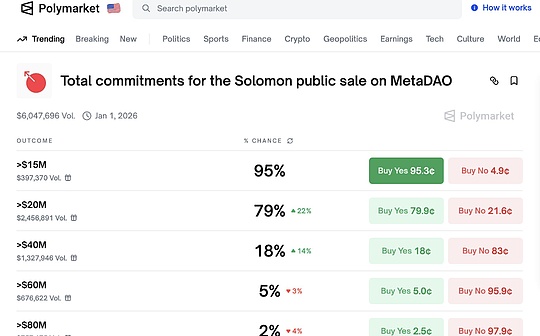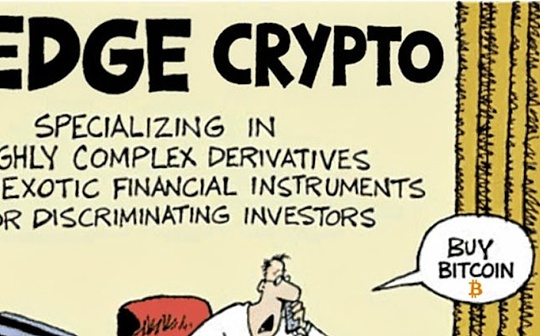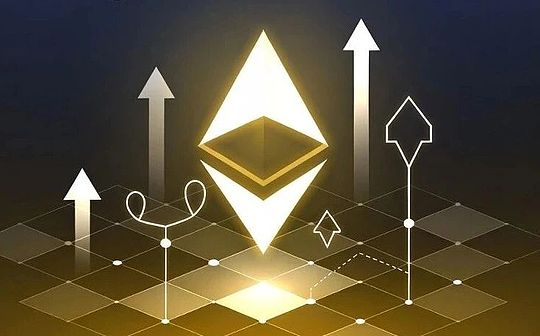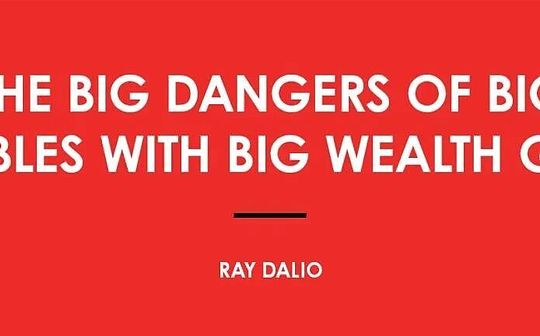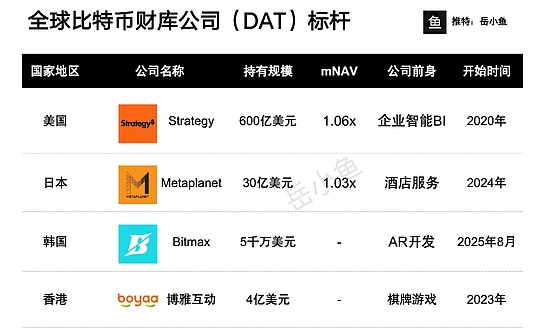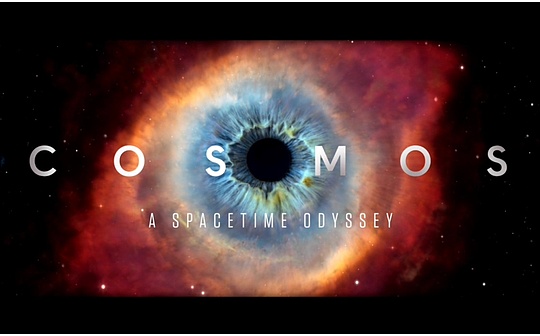
Key points:
-
Comparison of liquidity concentration: COSMOS ecology is highly dependent on its native asset ATOM in terms of liquidity, which is more concentrated than other ecology such as Polkadot.This concentration is for preliminary construction and ensuring ecology
-
Health has its positive effect, but there may be hidden dangers from a long -term perspective, especially when facing external market risks.
-
Cross -chain asset transaction activity: OSMOSIS has shown high activity and attractiveness in cross -chain transactions, which are significantly different from Injective and Kava.This means that OSMOSIS’s strategic layout and technical advantages in cross -chain are more prominent.
-
The development direction of native assets: Although native assets can bring stability to the COSMOS ecology, the lower liquidity of BTC and ETH indicates that the COSMOS ecology still has room for improvement in the introduction of cross -chain assets.
-
The health of the lending market: Umee and Kava Lend in the COSMOS ecosystem show certain limitations in the field of lending.Especially in comparison with other mainstream lending platforms such as AAVE and Compound, the liquidity and competitiveness of mainstream assets are obviously lacking.
-
Modular design: The biggest feature of COSMOS SDK is its modular design.It provides a series of preset modules, such as authentication, banking, governance, etc. Developers can directly use these modules to quickly build applications.For the DEFI project, this means that they can focus more on optimizing the user experience without the need to re -build wheels.
-
Flexibility: COSMOS SDK allows developers to write their own modules in Go language, which provides huge flexibility for the DEFI project.Developers can create new financial tools, trading types or other functions according to their needs, which is very important for the innovation of the DEFI project.
-
Cross-chain interaction: COSMOS SDK supports IBC (Inter-Blockchain Communication) protocol, which allows the chain in the COSMOS network to interact with each other and transmit data.For the DEFI project, this means that they can expose more types of assets and increase the appeal of their applications.
-
Security: Although the application chain needs to solve security problems in COSMOS, COSMOS SDK provides some built -in solutions, such as using the Staking and Slashing mechanisms to protect the security of the network.For the DEFI project, this reduces their difficulty in protecting network security.
-
Inclastic
-
Overview:
-
Kava is based on COSMOS SDK, which is a popular framework for building blockchain applications in Go.This provides Kava with modularity and interoperability capabilities.
-
It adopts a POS consensus mechanism based on Tendermint.Tendermint is famous for its faultness due to Byzantine, which ensures that cybersecurity and reduce the risk of dual expenditure attacks.
-
Kava Mint: This application allows users to mortgage their assets to obtain USDX loans.It is reminiscent of MakerDao’s system, but has its unique features, especially in terms of acceptance of mortgage assets.
-
Kava Lend: This is a currency market that users can provide and borrow assets to get rewards.Re -rename means its integration and alignment with a wider Kava ecosystem.
-
Kava Swap: This application name remains unchanged and promoted the purchase and selling tokens on the Kava chain.It uses automatic market business models to ensure that it provides traders with liquidity and competitive prices.
-
Kava: native currency of Kava blockchain.Play a key role in the security, governance and various mechanical functions of the platform.Its POS mechanism also means that the Kava token holders can mortgage their tokens to verify the transaction and get rewards.
-
USDX: Kava’s stablecoin, users can cast them by mortgaging their encrypted assets.It provides a stable exchange medium in the Kava ecosystem.
-
Hard: Kava Lend’s governance tokens.It is used to motivate early participants and guide the sustainable development and governance of products.
-
background:
-
In 2021, with the launch of Stkatom on Ethereum, PSTAKE became the first liquid pledge solution for $ Atom.
-
In 2023, Stkatom returned to the new IBC native version on the Persistence Chain.
-
Liquid pledge: PSTAKE solves the pledge dilemma of POS asset holders, allows them to pledge the tokens to get rewards and use them in DEFI.
-
How to work: Through PSTAKE, users can safely pledge their POS assets (such as $ atom) to get pledge rewards and get tokens (such as $ stkatom) representing the pledged assets.Opportunity.
-
Support chain: At present, PSTAKE supports the liquid pledge of the Binance Chain, COSMOS, Persistence and Ethereum.
-
Stkatom’s operation: It follows a exchange rate model. With the increase in pledge rewards accumulated by the underlying Atom, the value of Stkatom will also increase.
-
Cost: PSTAKE is low in order to ensure that the cost of user experience is set.
-
Security: PSTAKE has been audited by Halborn Security and Oak Security.PSTAKE has also held a vulnerability bounty event of $ 100,000 since April 2023 since April 2023.
-
Special features: PSTAKE has a unique “real -time redemption” function, allowing users to avoid the unlocking period of 21-125 days.
-
Wallet support: PSTAKE supports Keplr and Ledger when launching, and will soon support more software and hardware wallets.
-
Two -thirds of the exchange transaction fee received by the platform will be assigned to the liquidity provider (LP) of the corresponding liquidity pool.
-
The pledged VVS can get VVS or partner’s token reward.
-
Trading rewards: You can get rewards on the exchange currency on the VVS Finance platform.
-
Recommended plan: Recommended transactions to the platform can get rewards.
-
Statom provides solutions for the dilemma between liquidity and pledge rewards.With more than 70%of the market share and TVL of nearly $ 30 million, its dominance is obvious.The upcoming features of Stride, such as flow governance and instant redemption, further enhance its appeal.
-
Compared with STETH: STETH’s admission is that users want to drive leverage trading strategies to ETH add leverage through platforms such as Uniswap and AAVE.For example, as can be seen in the figure below, the use rate of STETH has been promoted by the launch of the AAVE V2 market, and the two have obvious correlation.STATOM focuses on transforming 70%of the pledged funds into liquid pledged funds, and most of the STETH is to convert the unpacking funds into liquid pledged funds.
-
Stride directly reward the agreement income to the pledker, and LIDO will deposit 10%of the pledge reward and deposit in Treasury.Therefore, the $ Strd pledge is more favorable.
-
In recent periods, the governance voting of LIDO on Snapshot shows that its governance participation rate is only about 1.5%of the currency holders.This shows that most of the high transaction volume of $ LDO is not for the desire to participate in governance.
-
Unique value claim: ICS allows the security of the ATOM verification set to copy on different application chains.The alliance between Stride and ATOM ensures the accumulation and value of ATOM pledges and enhances the encrypted economic security of the entire COSMOS HUB.
-
Liquid pledge module (LSM): LSM limit can be performed by 25%of ATOM pledge, thereby reducing the risk of liquidity pledge.At the same time, LSM also introduced the pledged Atom to immediately enter the liquidity pledge without going through a 21 -day solution.This framework regulates the adoption of liquidity pledge to prevent liquidity pledged providers from controlling more than one -third of the total pledge volume, avoiding correlators, and reducing potential maximum risks of joint liquidation.
-
Base:
-
OSMOSIS combines the benefits provided by pledge and liquidity, enabling investors to maximize their return.Unlike the traditional DEX, users must choose between pledge and provide liquidity, and OSMOSIS integrates the two.
-
OSMOSIS, as a platform that supports Staked Atom as LP, lays the foundation for the COSMOS LSDFI, and is why it can protrude from DEX in the COSMOS ecosystem.
-
Superfluid Staking: OSMOSIS has introduced a novel mechanism that investors can benefit from liquidity and pledge at the same time.This dual interest system allows users to use two ways to make money without choosing between the two.
-
Custom definition of liquidity pool: OSMOSIS allows users to regulate the parameters of the autonomous dynamic pool, such as costs.This decentralized AMM framework allows market participants to find the best balance between fees and liquidity, rather than comply with the rigid protocol parameters that have been stipulated.
-
Market competition: DEX market competition is fierce.OSMOSIS needs to continue to innovate to maintain its unique value proposition and attract users.
-
Safety: Like all DEX, security is very important.It is crucial to ensure that funds are safe and smart contracts are free of vulnerabilities.
-
Adopt: OSMOSIS’s success will also depend on the wider adoption of the COSMOS ecosystem.If COSMOS gets more attention, OSMOSIS is likely to benefit.
-
The core construction of injective protocol:
-
Injective Chain: Completely decentralized side chain based on COSMOS Tendermint, as a Layer-2 derivative platform, transaction execution coordinator and decentralized order book.
-
Layer-2 high-speed protocol: Injective chain provides strong cross-chain compatibility and liquidity through the two-way anchor with Ethereum.
-
Decentralized order book: Injective provides a decentralized order book that implements transaction matching and settlement on the chain.
-
Free Market Transaction: Injective allows users to create their own derivatives market and provide a completely derivative derivative transaction environment.
-
Injective Exchange Client: User’s front -end interface.
-
Injective API: Connect to the INjective Exchange client and the middle layer of the COSMOS layer.
-
COSMOS layer: blockchain based on Tendermint, supports instant confirmation.
-
Ethereum layer: consisting of Injective Bridge smart contract, which realizes the two -way anchor with Ethereum.
-
Injective coordinator contract: coordinates the derivative transactions in Ethereum and injective chains.
-
Staking Contract: Manage the core function of pledgers on the Injective Protocol.
-
Injective derivative contract: allow traders to create and use decentralized perpetual contracts.
-
Injective Bridge contract: Manage the two -way anchor between Ethereum and Injective Chain.
-
Injective Tonglin Contract: ERC-20 contract designed for Inj.
-
Depending on the development of assets on cosmos
-
Unique value proposition
-
Cross -chain interoperability: Umee allows different blockchain (such as Ethereum and COSMOS) to seamless interaction.This interoperability means that users are not limited by a blockchain ecosystem, but can use assets and opportunities across multiple chains.
-
Equity assets of mortgage: One of the unique features of umee is that the equity assets of the equity certificate (POS) blockchain can be used as mortgage.This means that users can mortgage their equity assets without losing potential equity rewards.This is a dual benefit -gain from equity and gain liquidity at the same time.
-
Algorithm interest rate: Umee uses the interest rate determined by algorithm.These interest rates are adjusted according to market conditions to ensure that they provide users with fair and dynamic borrowing interest rates.
-
Security and efficiency: By using bridges such as Gravity Bridge to connect solutions, Umee ensures the security and efficiency of cross -chain interaction, which is critical to trust in the DEFI field.
-
Liquidity flow: By allowing other chains to assets, especially popular chains like Ethereum, are used for the COSMOS ecosystem, and there may be a large amount of liquidity.More liquidity usually means a more powerful borrowing market.The figure above shows the assets of other chains supported by umee.
-
Increasing the effectiveness of pledge assets: COSMOS has nearly 70%of assets pledged.Umee uses these pledge assets as a mortgage model to unlock a large amount of value and promote more activities and growth in the COSMOS lending market.
-
Attract new users: Cross -chain functions can attract users of other ecosystems to COSMOS.If they can easily move and use their assets between chains, the friction of entering the COSMOS DEFI space will be reduced.
-
Innovative lending mechanism: UMEE’s general capital facilities, aiming to promote lending in cross -chain, can introduce new financial products and services to further enrich COSMOS borrowing ecosystems.
-
Sommelier’s value proposition:
-
Smart vault: The characteristic of the Sommelier vault is that they can adapt to change:
-
Chain calculation: Sommelier’s architecture allows the chain to re -balance calculation.This not only ensures that the strategy is kept private, but also uses complex data modeling technology, similar to the technology used in traditional finance.
-
Bridge assets: Sommelier provides multi -chain access, without bridging assets, reducing complexity and potential risks related to asset bridges.
-
Decentralization governance: transactions and operations on Sommelier are managed by the assembly of the verification device to ensure the security of user funds and the response to user preferences.This decentralized method ensures that the platform maintains resistance.
-
Increasing liquidity: Sommelier may bring more liquidity to the COSMOS ecosystem through the bridge and introduce smart vaults, which is essential for prosperous borrowing markets.
-
Innovative lending mechanism: The adjustability of the Sommelier vault means that they can adapt to market conditions and may introduce new lending strategies to enrich COSMOS’s borrowing ecosystem.
-
Reduce cost: Sommelier’s aggregation and batch treatment of transactions can cause reduced natural gas costs, making borrowing on COSMOS more economical and efficient.
When multiple blockchain projects are fighting for dominant power, each tried to become “the next Ethereum” or “Blockchain 3.0”, COSMOS has chosen a different path.
Everything starts with a simple idea: how to create a decentralized and interoperable blockchain network, rather than a single, isolated ecosystem?COSMOS’s design philosophy is to solve this challenge.Its vision is not only to create another blockchain, but to build a “Internet” that can connect to all blockchain, a network that allows various blockchain to communicate and interact freely with each other.The concept of “link blockchain” has been widely used by many cross -chain projects and main networks, but in contrast, COSMOS is the most successful so far, providing stronger connection and higher developer freedom.
From the idea to practice
Design philosophy
>
As a tendermint consensus, COSMOS is different from most blockchain projects at that time.COSMOS provides developers with a consensus mechanism and application development tool (SDK), not a traditional execution engine (virtual machine).This innovative model provides developers with a higher degree of freedom, allowing them to customize the operating environment and trading types of the application chain according to their specifications.
Interestingly, in the initial development stage of COSMOS, its cross -chain technology has started fierce competition with Polkadot as its core competitiveness.With the gradual development of the two, we can see that they have moved towards completely different technical paths.Polkadot uses its cross -consensus information format XCM to create a barrier -free cross -chain information flow infrastructure.In addition, Polkadot shared the security of the design and sharing of the designs of the relay chain, and each parallel chain directly obtains the security of the relay chain through the built -in parallel chain protocol.Instead, the COSMOS ecology and its various chains do not rely entirely on the COSMOS Hub to obtain inter -chain communication and security.COSMOS adopts a mesh structure, and its application chain needs to be responsible for the security of its own chain.This design means that the DEFI project of the COSMOS ecology can have greater flexibility and autonomy.
COSMOS’s core components include COSMOS SDK, IBC protocol and Tendermint consensus engine.COSMOS SDK, as a set of open source frameworks and public chain construction tool packages and template libraries, greatly reduces the difficulty of developer development blockchain and related applications.The IBC protocol allows different blockchain to perform information exchange and interoperability, so that each blockchain in the COSMOS ecosystem can form a joint network.Tendermint consensus engine provides an efficient and reliable consensus mechanism that allows nodes in the blockchain network to achieve consensus quickly and fairly.
Using the powerful tool library provided by the COSMOS SDK, Defi developers can establish and run their own applications more easily.Specifically, its superiority is reflected in the following aspects.
In general, through the COSMOS SDK, Defi developers can quickly develop high -performance, innovative and secure applications, and can also use COSMOS network cross -chain interaction capabilities to expand the influence of its application.
Market overview
COSMOS’s DEFI market is roughly divided into the following five categories:
>
*In view of the COSMOS ecosystem, each project is basically an independent public chain. This classification is based on its main use, and the INFRASTRUTURE class is based on its ecology is too large and diversified.
COSMOS is a project dedicated to providing a modular blockchain solution. It provides convenience by enabling developers to create a public chain that is suitable for their own application.COSMOS can be connected to each other through its blockchain communication protocol (IBC) enable applications and protocols in the ecosystem to achieve free exchange of cross -chain assets and data.The widespread application of COSMOS SDK enables many public chains to create their own ecosystems, which also include some DEFI applications.
2. Liquidity Staking
COSMOS’s liquidity market is currently dominated by the two projects of Stride and PSTAKE. Both offer POS pledge derivatives.Stride allows users to obtain asset liquidity while maintaining POS pledge income.Similarly, PSTAKE users can pledge assets to obtain pledge returns. At the same time, in the DEFI, the pledge representatives to obtain additional income, and transferred between different networks through the IBC protocol.At present, the pledge voucher obtained by related Token after participating in the pledge is difficult to have a large use scenario in the relevant DEFI agreement.Compared with the use scenario of ETH pledge related vouchers, the pledge market of the COSMOS ecosystem also needs a longer development process.
3. Vaults
The COSMOS’s vault market is currently developing towards a more complicated and more adaptable strategy, surpassing the past simple funds and basic strategies.Sommelier’s “smart vault” is the representative of this transformation.Traditional methods, such as investing in index investment portfolios or specific pools, and re -investing income over time, are becoming outdated.In contrast, the focus is turning to adjust the smart vault that can be adjusted according to the current market conditions or scheduled indicators.The transition to the smart vault marks the major progress of the COSMOS vault market.The smart vaults in the new era can adapt to market changes and provide more flexible, more agile, and more favorable possibilities for DEFI users.
4. Lending & amp; BORROWING
The COSMOS borrowing market is currently developing. UMEE is the main borrowing agreement. It provides a universal cross -chain lending function and introduces the basic principles of the traditional debt market.
5. DEXES
COSMOS’s decentralized exchange market is rapidly developing. Crescent and OSMOSIS are two of them. They both aim to provide efficient capital utilization and liquidity.The decentralized exchanges on COSMOS, such as OSMOSIS, have high interoperability through COSMOS’s cross -chain communication (IBC) protocol, allowing different blockchains to expand its ecosystems and communities.Capital configurations can use DEX such as OSMOSIS to make use of their capital to earn transaction costs by providing liquidity, and to obtain additional incentives through liquidity mining, thereby providing richer liquidity and reducing trading slippery points.
>
The COSMOS ecosystem of the Cronos chain and the Kava chain are the most mature. The number of agreements between the two is over 100, and they are far ahead of other projects.
>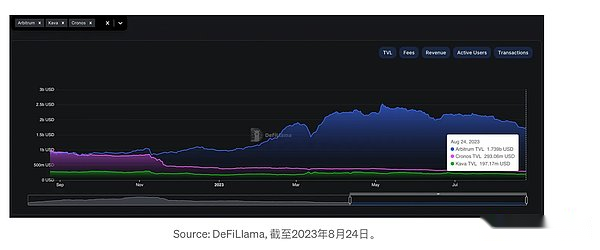
But when compared with other Layer2 projects (such as Arbitrum), the tvl of the two can be said to be insignificant. Arbitrum is nearly 5-10 times that of the two, and the two also lack the support of star projects. The above picture shows that the two have begun since the beginning of the year.The TVL is not too undulating.
>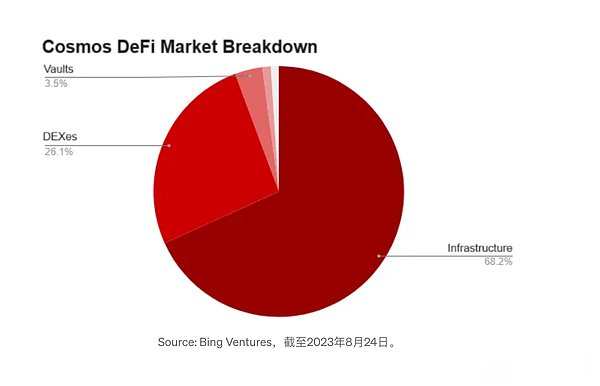
The above cake diagrams show the composition of the COSMOS DEFI market. The data is only based on the directly established protocol established in the COSMOS SDK. Some projects are not calculated based on the public chain established with COSMOS SDK.
As shown in the figure, the COSMOS Defi ecosystem is the largest in lock -ups, mainly because it contains many public chain projects.They also have a Defi ecology in themselves. For example, there are 108 projects on Cronos, and Kava has also built a complete set of DEFI basic services. Kava Mint, Kava Lend, Kava Swap’s total locking value has reached US $ 200 million.The three cooperate with each other to realize the closed loop of the Kava DEFI business scenario.
Dexes is the second section of locking volume. The main contributors are OSMOSIS and Thorchain, and the two also support the Dexes business of COSMOS.The Superfluid Staking function provided by OSMOSIS has successfully maintained the status of OSMOSIS Dex. It allows usersWith both liquidity, expand user returns to the greatest extent.
The biggest selling point of the COSMOS DEFI ecology is its diversified product. The protocol derived from COSMOS SDK alone has nearly 400. In addition, the convenience of construction at the technical level has also attracted a lot of BUILDERS to build.Although it seems that other plates such as Lending & Amp; Borries and Vaults accounted for a small proportion, in fact, more projects are built based on public chains on COSMOS.Detailed analysis.
Scanning map: The dull ecological difference is thunderous
Infrastruture: The main project TVL is frustrated, and the future development is to be observed
Kava
>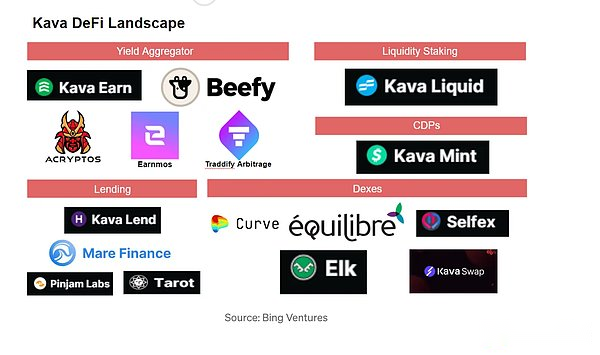
2. Main application:
3. To tokens ecosystem:
>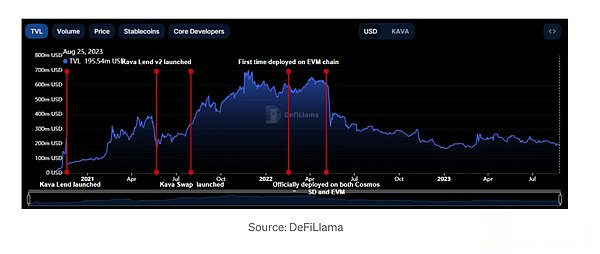
The figure above shows the narrative of Kava’s development events.The development of the three major applications of the early Kava (Mint, Lend, SWAP) has very positive help to the development of ecology.Later, as the KAVA network was officially completed and started, the co -chain architecture of Ethereum and COSMOS was realized.Developers will be able to seamlessly build in EVM and COSMOS SDK execution environment.Unfortunately, with a series of events that occurred in 2022 (Terra closure, Celsius was unable to repay user funds), Kava was also affected by the general environment and caused TVL to decline significantly until it has not recovered until now.
Persistence
>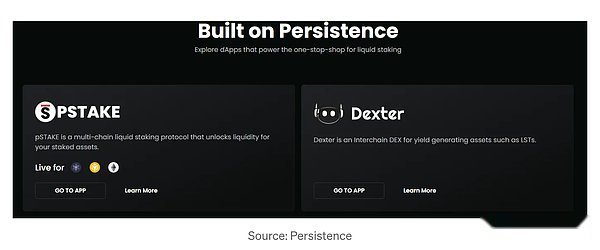
Persistence aims to promote institutions to open finance. It provides seamless solutions for global value flow by promoting cross -chain interoperability.In the Persistence ecosystem, a set of cutting -edge financial products, such as PSTAKE and Dexter.
pstake
2. Core function:
>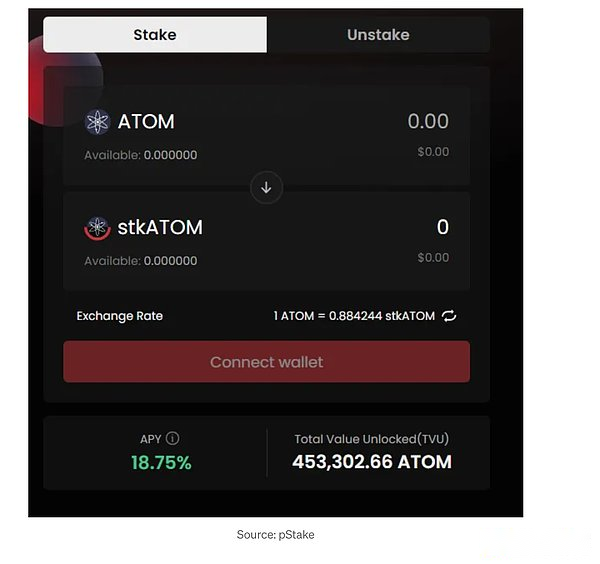
3. Features:
>
Source: dune analytics @shini
Liquid Staking is very important for the economic benefits of a network and the driving force for pledge, and PSTAKE also tries to play this role.However, because the COSMOS ecosystem’s DEFI has always had less capital inflows, the funds of liquid Staking are usually sucked by Ethereum, and ATOM’s currency price is relatively inferior. The performance of PSTAKE’s TVL is also unpredictable, and it has not been supported by users.
Cronos
>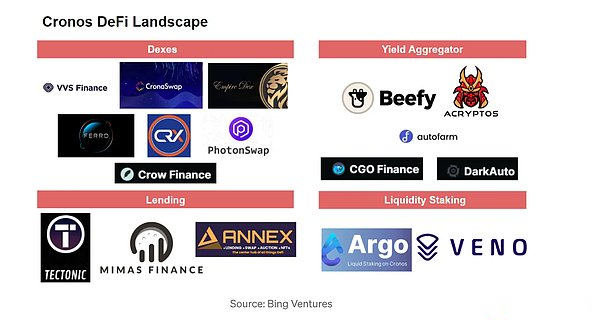
Crypto.org Chain was launched in March 2021. It is a public blockchain developed by Crypto.com, which aims to achieve fast and security transactions at low costs.The Cronos side chain is compatible with Ethereum EVM, allowing Ethereum’s Dapps and Defi ecosystems to migrate quickly.
Vvs Finance
VVS Finance is the first native AMM decentralized exchange based on the CRONOS blockchain.The project uses some protocols that have been proven and audit.Different from other projects, VVS Finance has a relatively comprehensive reward plan for different participants, which are supported by them to manage token VVS.
Tectonic
Tectonic is a lending agreement on the Cronos chain, which is equivalent to VVS Finance.It is the fork of the Compound protocol.
>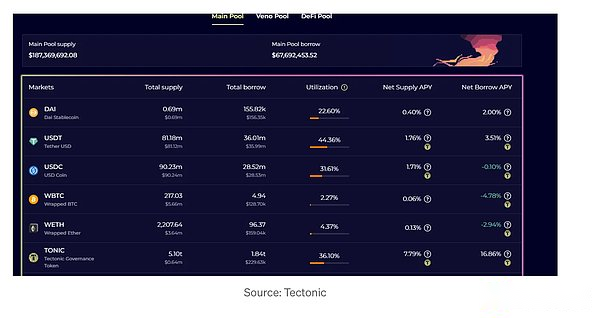
TECTONIC allows users to want the platform to provide cryptocurrencies as liquidity providers to earn interest and Tonic token awards.
Each asset has a corresponding mortgage coefficient (that is, the ratio of loan mortgages), which means that each mortgage asset can be borrowed.For example, 75%of the mortgage coefficient means that users can borrow other cryptocurrencies equivalent to 75%of the value of mortgage assets.If the value of mortgage assets decreases or the value of borrowing assets increases, some unpaid borrowings will be discounted on the basis of market price.
>
Tectonic and VVS Finance are important projects in the Cronos DEFI ecosystem.It can be seen above that although the total locking volume of VVS Finance was much higher than Tectonic at the beginning, after the disaster of a series of DEFI/CEFI, the TVL of the VVS Finance was 7 times from the highest peak and Tectonic.They were maintained smoothly at the low position, and the gap was narrowed to about 2 times.The two are also a microcosm of the Cronos Defi ecology. In the future, there will be sufficient catalysts -stable and prominent project development in order to have the opportunity to save the downturn TVL.
Liquidity Staking: The huge potential and economic mechanism of liquidity pledge
>
>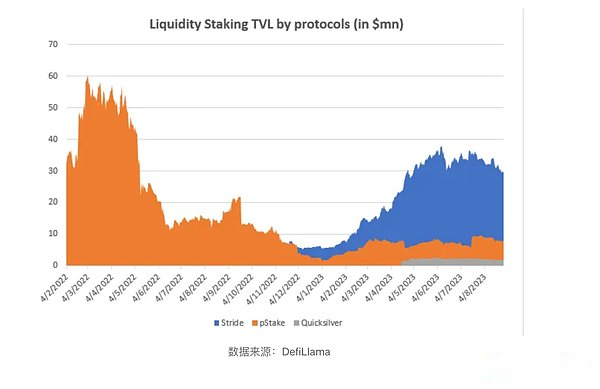
From a macro perspective, about 20%of the Ethereum network has a total supply of pledge, while the COSMOS HUB has about 70%.However, only 1.5% of these 70% of the pledged Atom are liquidity pledge, while ETH is as high as 9.3%.It can be seen that from the perspective of economic benefits, ETH’s liquidity pursuits are more leading and mature, which is also the reason why Ethereum’s DEFI leads COSMOS.
But at the same time, this is also the element of COSMOS DEFI. It has a 70%pledge ratio that makes COSMOS the basis for developing liquidity pledge.Defi ecology brings considerable benefits.In the existing market of COSMOS liquidity, Stride’s TVL is far ahead, as high as 75%, and PSTAKE is the second leader in the past, accounting for about 20%.
>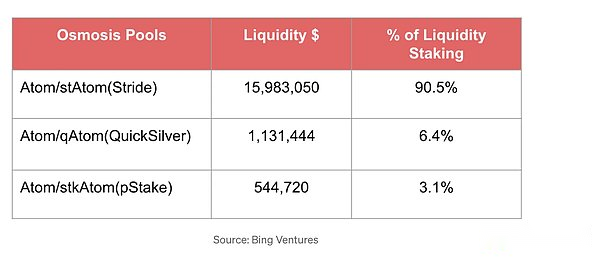
Stride
Driven by Stride’s liquidity pledged token STATOM, the COSMOS DEFI ecology is experiencing surge in.A unique value proposition of Stride is to reward the pledgers directly with the agreement through the $ STRD.In addition, Stride will also obtain the protection of the Interchain Security (ICS) mechanism of COSMOS Hub to further enhance its security.With the increase of the ecosystem, the demand for $ STRD is expected to increase, promoting the further adoption of STATOM.
Statom liquidity and adoption:
>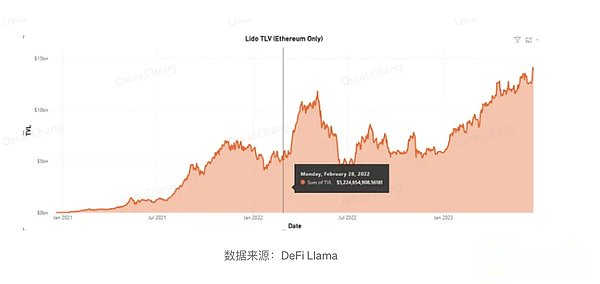
>
$ STRD tokens and the similarities and differences with $ LDO:
Interchain Security (ICS):
With the adoption of the entire COSMOS ecosystem, the combination of liquidity pledge and LSM will promote the use of STATOM in the COSMOS DEFI ecosystem, thereby increasing TVL on the lending market and DEX.With the enhancement of the STRIDE market penetration, more and more costs paid to pledges, demand for $ STRD may increase.
DEXES: OSMOSIS and Injective’s dominance, as well as the future of liquidity
>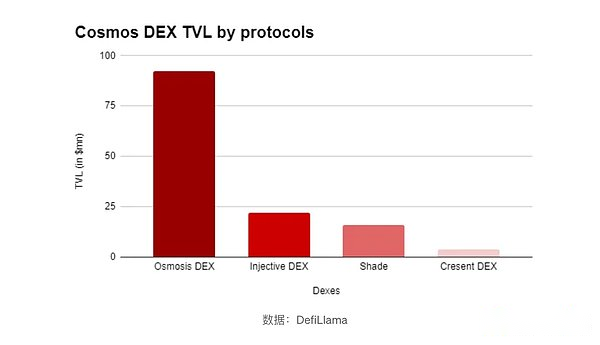
In COSMOS’s DEX, OSMOSIS is of course the secondary protocol. The various Staked Atom mentioned above is mainly LP on the protocol, thus becoming the main pillar of COSMOS Defi.As can be seen from the figure above, the TVL of other projects is relatively low, with an average of only $ 25M, and most of the funds are gathered on OSMOSIS Dex.
>
Even though OSMOSIS has a leading position on COSMOS, the liquidity and usage of the entire DEX market are still relatively low.The picture above is the comparison of the TVL of Balance V2 and OSMOSIS. Before the DEFI / CEFI series of crises (before the summer vacation of 2022), OSMOSIS’s TVL can barely follow the Balancer V2, but the later protocol was pumped in a large amount of liquidity.$ Atom is not a worthy asset that is worth holding. Therefore, OSMOSIS’s TVL has not improved after the summer vacation in 2022, maintaining a low position.
Osmosis
>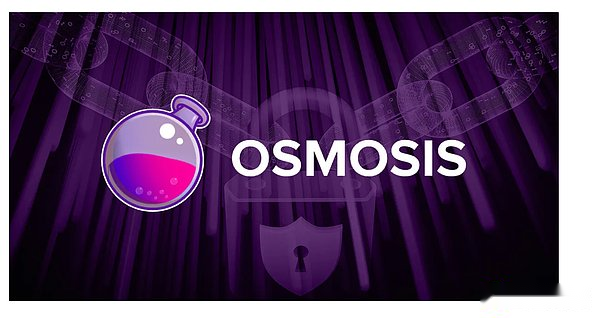
OSMOSIS is designed to be designed by the COSMOS ecosystem. The DEX that is automatically made on the automatic market (AMM) mechanism.By integrating the IBC protocol, it supports cross -chain transactions, and also provides good flexibility and combinedability.
2. OSMOSIS as the advantage of DEX:
3. Following points and consideration:
Injective Protocol
Injective is a DEX that provides cross -chain margin transactions, derivatives and foreign exchange futures transactions.It uses COSMOS-based Layer-2-side chain technology to achieve the characteristics of zero GAS costs, high-speed transactions and completely decentralization.
2. Technical component of Injective Protocol:
3. Injective Protocol’s smart contract:
DEXES’s outlook
>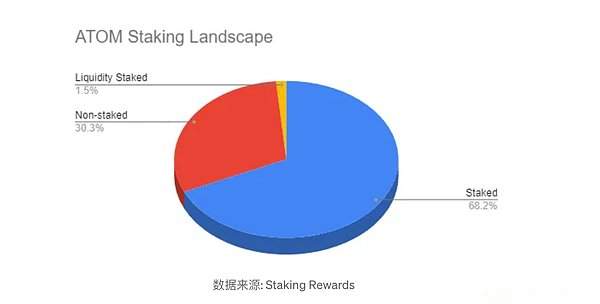
Dexes development depends to a large extent on the use of LST assets.LSDFI will become a brand new income field.Taking LSDFI on Ethereum as an example, its market value has reached $ 1.9 billion.If COSMOS also successfully developed its own LSDFI ecosystem, the most direct beneficiary will be Dexes.In addition, LSTFI can bring more users to DEX.In the LSTFI ecosystem, users can not only earn benefits through transactions, but also earn income by providing liquidity.This new income model will attract more users to use DEX to further promote the development of DEX.
2. Ecological restrictions
>
>
The advantage of COSMOS is that it creates an ecosystem consisting of many protocols. These protocols are connected to each other through Inter-BlockChain Communication (IBC) technology.However, this is also a double -edged sword, because in the COSMOS ecosystem, many decentralized exchanges (Dexes) are mainly established around the COSMOS ecology assets.
In these DEXES, the main tokens of the transaction are platform tokens based on projects established by COSMOS SDK, such as OSMOSIS and Shade protocols.The assets of many liquidity providers (LP), such as Statom, SHD, AKT, Inj, etc., are tokens of the COSMOS ecosystem.This has led to LP lacking popular assets other than COSMOS, which limits the liquidity growth and usage of these DEXES to a certain extent.
In order to grow these DEXES, a possible strategy is to promote tokens on COSMOS and make them more widely traded.However, this strategy is also limited because it depends on the growth and development of the cosmos ecology.
On the other hand, COSMOS and its DEXES can consider introducing popular assets other than COSMOS.This can be achieved by establishing a cross -chain bridge or cooperating with other blockchain platforms.Introducing more external assets can not only increase the liquidity of Dexes, but also attract more users to use Dexes to promote the growth of Dexes.
Lending: Waiting for the strange point of cross -chain lending
>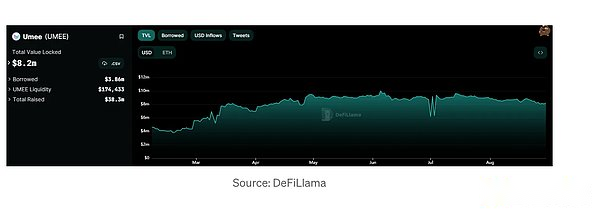
Umee
Umee is a platform that is mainly borrowed.It aims to connect to various blockchains, allowing users to mortgage assets on one chain and borrow assets on another.This interoperability is an important feature, especially in the field of blockchain, assets and liquidity are often restricted in specific ecosystems.
>
2. Promote the COSMOS lending market:
>
Outlook of Lending Market
Basically, the same situation as DEX depends on the development of cosmos pledge assets and ecological restrictions.Simply put, pledge assets will also be an important factor in determining the release of the borrowing market in the future. The market is also limited by focusing on focusing on COSMOS ecological assets., But it is not always the main target of users.
>
As can be seen above, the main services of the two main lending agreements are still assets (Statom, OSMO) on stablecoins and COSMOS, and assets that have not seen other chains have been performed in large numbers.This limitation may hinder the further development of the market.
VAULT: Intelligent vault and cross -chain technology to promote liquidity and diversity growth
Sommelier
>
Sommelier is a decentralized asset management agreement that introduces the concept of “smart vault” in the DEFI field.Unlike the traditional static strategies that may become outdated due to market changes, Sommelier’s vault aims to predict, respond, optimize and evolve according to the real -time DEFI market conditions.It is based on COSMOS SDK and has a high -value EVM network, which allows seamless integration between different blockchain ecosystems.The project’s TVL has risen steadily since Real Yield ETH Cellar was launched. It is an essential bridge for the COSMOS ecological connection to external interest generation protocol.
——Pourage — Using prediction methods to estimate future benefits.
—— Reaction -Adjust the main market changes, adjust the position and leverage ratio to prevent potential liquidation.
—— Optimization -Implementing efficient leverage solutions to reduce related costs.
—— Evolution — Extract new income opportunities by updating its algorithms and protocols.
2. Promote the COSMOS lending market:
VAULT market outlook
Sommelier’s smart vault and cross -chain features not only provide users with more advanced asset management tools, but also bring wider mobility and diversity to the COSMOS ecosystem.
Sommelier’s unique structure, especially its ability to calculate and bridge -free assets, provides DEFI with a more efficient, secure and economical solution.This model may attract more developers and projects to the COSMOS platform because it provides a more flexible and scalable environment to build and optimize DEFI applications.
In addition, Sommelier’s decentralized governance and authentication collection ensure the transparency and security of its protocol, which will further enhance users’ trust in the COSMOS DEFI ecosystem.
In short, with the further development and improvement of Sommelier, I believe it will make important contributions to the prosperity and growth of Cosmos Defi, and bring new opportunities and possibilities to the entire cryptocurrency field.
Observation
Liquidity concentration: The high dependence of ATOM has further increased its token narrative pressure
The correlation between liquidity concentration and protocol value
In the field of blockchain and decentralized finance (DEFI), liquidity is a key indicator that can reflect the health status and attractiveness of an agreement or platform.The higher the liquidity, the lower the cost of the user on the platform and the faster the transaction speed.
The native assets of the COSMOS main chain are widely used in multiple DEFI protocols.If ATOM’s liquidity in a protocol is high, this means that the agreement highly relies on the assets of the COSMOS main chain.In other words, if the assets (ATOM) of the COSMOS chain (ATOM) are removed in large quantities in this protocol, the value of the agreement may be seriously affected.
The relationship between Atom and agreement value
If most of the value of a protocol is concentrated on Atom, then we can say that the value of the agreement depends to a large extent on Atom.This means that any factors that affect ATOM value, whether it is market dynamics, technical updates, or governance decisions, may indirectly affect the value of the protocol.
>
The concentration of liquidity in the cosmos ecosystem shows its high dependence on native asset ATOM.From a data point of view, the average proportion of LP pools composed of ATOM assets (including pledom assets including Statom, QATOM) accounts for about 40 %.This means that the protocol in the COSMOS ecosystem is relatively highly concentrated in ATOM assets in terms of liquidity. It is different from mainstream liquidity providers in UNISWAP, BALANCER and other monographs to provide the liquidity of different assets.
The importance of liquidity
In the field of DEFI, liquidity is a key indicator.High liquidity means that users can trade easier and faster, and the transaction cost is also low.For any DEFI protocol, maintaining high liquidity is very important because it can attract more users and funds.ATOM has a high proportion of LP pools to play a good barriers to provide a source of funds for assets.
Characteristics of cosmos
COSMOS uses its COSMOS SDK and super chain to allow various blockchain to communicate and interact freely.This allows the protocol in the COSMOS ecosystem to better provide liquidity for ATOM.In addition, due to the cross -chain characteristics of COSMOS, it can interact with the assets of his chain to further enhance its liquidity.
>
As auxiliary examples, the liquidity concentration in the Polkadot ecology is relatively low.This means that the liquidity in the Polkadot ecosystem has a lower dependence on DOT, or the liquidity contribution of other assets in the Polkadot ecosystem is greater in liquidity.This is in sharp contrast to COSMOS, showing the advantages of the barriers of native assets (ATOM) on COSMOS.
Cross -chain asset transaction activity: The big ecology does not show due interaction and active, but reflects a certain amount of closedability
>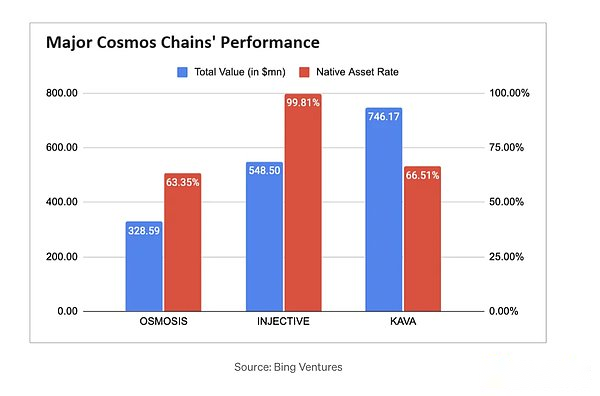
In order to understand the activity of cross -chain asset transactions, we chose the three public chains with the highest market value on the IBC Network to observe their cross -chain performance.From a macro perspective, these three public chains basically use ecological assets as the main chain assets.Among them, Injective’s ecological assets account for nearly 100%.This shows that the public chain on IBC Network is currently more inclined to focus on developing its own internal ecology.
>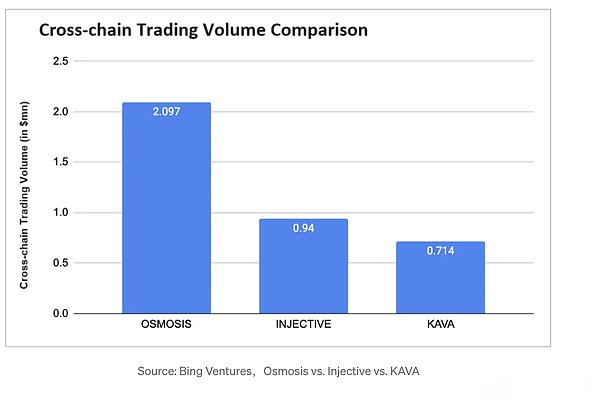
OSMOSIS has the highest total cross -chain asset value, which is almost twice as much as Injective and nearly three times that of Kava.This shows that OSMOSIS leads the other two public chains in the activity and attraction of cross -chain transactions.
Reflect of cross -chain activity
The total value of OSMOSIS’s high -span chain assets reflects its core advantage as DEX and its ability to attract cross -chain liquidity and transactions.This also means that OSMOSIS’s users and projects are more inclined to conduct cross -chain transactions.Although the total value of cross -chain assets is lower than OSMOSIS, its value is still quite high, which reflects its cross -chain transaction activity in certain specific assets or transactions.Kava has the lowest total cross -chain asset value, which is related to its core business as a loan platform.It focuses on borrowing activities in the chain, not cross -chain transactions.
>
The characteristics of native assets are mainly
OSMOSIS, Injective and Kava are mainly based on native assets, which reflect the development of the COSMOS ecology at the current stage.The high proportion of native assets may mean that these public chains attach more attention to their own ecological construction and the development of internal applications.
The lack of BTC and ETH
Although BTC and ETH are the two major assets in the cryptocurrency market, they have relatively small liquidity on OSMOSIS, Injective and Kava, especially in Injective and Kava.This means that the COSMOS ecology is still in the initial stage in the introduction of cross -chain assets.
COSMOS ecology closedness
This closure of the cosmos ecology may be intentional to protect its internal ecology from the influence of external market fluctuations.On the other hand, this also reflects the choice of technical and strategy of the cosmos ecology, that is, pay more attention to the interaction between the internal chain and chain of the IBC Network.
The health of the lending market: lacks attraction for mainstream assets, lack of radical innovation
In the current cryptocurrency ecosystem, the lending agreement has become an indispensable part, which provides users with a decentralized way to borrow or lend assets.In order to better understand the performance of the lending protocol in the COSMOS ecosystem, this comparison will start from Umee, Kava Lend, and AAVE and Compound in other ecology.Through this contrast, we can clearly see the status and potential of the COSMOS ecology in the field of lending, and the differences and characteristics of its mainstream lending agreement.
>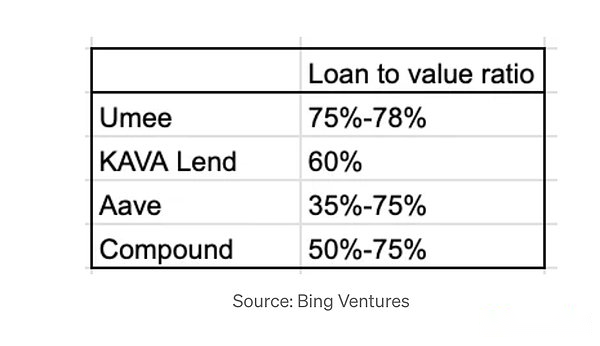
The borrowing mortgage rate on COSMOS is basically the same as the public, about 75%.
>
Umee, as one of the main lending agreements on COSMOS, provides the BTC interest on other famous projects, but is led by AAVE in ETH and USDT.Kava Lend has no ETH and USDT data.The lending agreement on the COSMOS is more focused on the asset borrowing of its own ecology, and its lower interest rate has not attracted investors to enter the market.In order to succeed in the fiercely competitive DEFI market, these agreements may need to consider adjusting their strategies, increasing interest rates or introducing other incentive measures to attract users.
>
From the perspective of liquidity, the lending agreement in the COSMOS ecosystem does have obvious limitations.The liquidity of Umee and Kava Lend is mainly concentrated on the tokens of the COSMOS ecosystem, which is obviously gaplated with the mainstream BTC, ETH, and USDT.
The liquidity advantage of its own ecological assets
The liquidity of the COSMOS ecosystem on Umee and Kava Lend is significantly better than other assets.This high -current lixture provides a stable market for the tokens of the COSMOS ecosystem to help maintain its value and demand.The concentration of liquidity also provides a certain degree of price stability for the COSMOS ecosystem to reduce the impact of market fluctuations.
Limitation of liquidity
Although the COSMOS ecosystem of tokens enjoys high liquidity on these protocols, this also limits the inflows of other mainstream assets and stable coins.BTC and ETH, as the two leading assets of the cryptocurrency market, are crucial for any DEFI protocol.This strategy of Umee and Kava Lend may have its advantages in the short term, but in the long run, it limits these protocols to attract the ability to attract more users and funds.
Market competition and strategy adjustment
The current DEFI market is fiercely competitive, and each public chain and agreements are trying to provide more asset pairs and services to attract users and funds.In this environment, too much dependence on its own ecological assets may cause the COSMOS ecological borrowing agreement to be at a disadvantage in competition.In order to cope with this competition, the COSMOS ecological borrowing agreement needs to adjust its strategy, introduce more mainstream assets and stablecoins, and provide more competitive interest rates and services.
Conclusion and outlook
In general, the COSMOS Defi ecosystem is not a stack of a single DEFI project.COSMOS built a large infrastructure ecosystem. Each DEFI project can be a public chain or a project on the public chain; this situation also makes COSMOS’s DEFI ecosystem more complicated.The project can be a chain, which will develop its own ecology in the future; it can also be a project, which can cross the chain to other chains to make your own single -a -segment track (such as DEX, Lending, etc.).
Release ATOM value
The COSMOS DEFI market is in a critical stage of development. Among them, the introduction of LSMOSIS, such as Stride and OSMOSIS, brings new vitality and opportunities to the entire ecosystem.Stride provides ATOM as an opportunity for LST assets, and OSMOSIS provides a LSTFI platform, providing a strong foundation for COSMOS to better operate with other blockchain ecosystems.But COSMOS’s Staking ecology has a large gap compared to Ethereum, and the Staking ecology has a high dependence on the core main network ecosystem. Therefore, the Staking ecology of COSMOS will largely depend on the development of the cosmos ecology itself.
For ATOM’s Staking Derivatives Innovation Project, we must not only think about providing opportunities for ATOM holders, mortgage it on the verificationrs, but also consider obtaining liquidity through cross -chain derivatives markets.This not only increases the liquidity of ATOM, but also brings additional benefits to users outside the ecology.In short, COSMOS now lacks a black hole like Terra.
Innovation of cross -chain asset management
Sommelier provides users with advanced asset management tools with its intelligent vault and cross -chain function, and also brings a broader liquidity and diversity to the COSMOS ecosystem.Its unique chain computing and bridge -free asset capabilities provide a high -efficiency, security and economic solution for DEFI, which attracts more developers and projects to the COSMOS platform.
In addition, the introduction of native USDC also solves the problem of COSMOS’s long -term lack of stable currency, providing market participants with better chain trading strategies and risk management tools.
The track we are concerned
Transaction polymer and cross -chain bridge:In the multi -chain world, the trading polymer and cross -chain bridge provides users with seamless experience, and can easily transfer asset transfer between different chains.COSMOS’s IBC (Inter-BlockChain Communication) is a perfect example, but in actual applications, there are more space to expand this field.
Stable currency and currency market:COSMOS ATOM, as a native currency, has irreplaceable value within the ecology.However, in order to greater stability, a stablecoin system is needed.The opportunity here is to develop a stable currency system that is closely combined with ATOM, and combines different fields and types of currency markets, such as RWA.
From the perspective of the overall market, the current Crypto market is in the bear market as a whole, and the liquidity is relatively scarce.The DEFI project of the COSMOS ecology has received the influence of the overall market environment. At present, TVL is generally not high.The ecology of COSMOS itself is based on its special heterogeneous architecture. The Utility of its token Atom has always been controversial by the market and community.But COSMOS’s uniqueness and change have also attracted many developers to participate in the COSMOS ecosystem.At the same time, with the development of the Crypto ecology, a lot of old -fashioned projects will choose to transfer from a single project to developing its own public chain.one.
At the same time, Ethereum’s DEFI innovation is shifting to the second layer. Because there is no native interoperability, liquidity will continue to be fragmented, and the growth of the overall ecosystem will have some obstacles.In contrast, COSMOS Defi is booming with its native IBC interoperability.
In general, the development momentum of the COSMOS DEFI market has brought huge growth potential to various innovations and projects.With the introduction of more projects and technologies, I believe that the COSMOS Defi market will continue to expand. The premise needs to effectively release the value of pledged assets and solve the problem of liquidity of the agreement.

